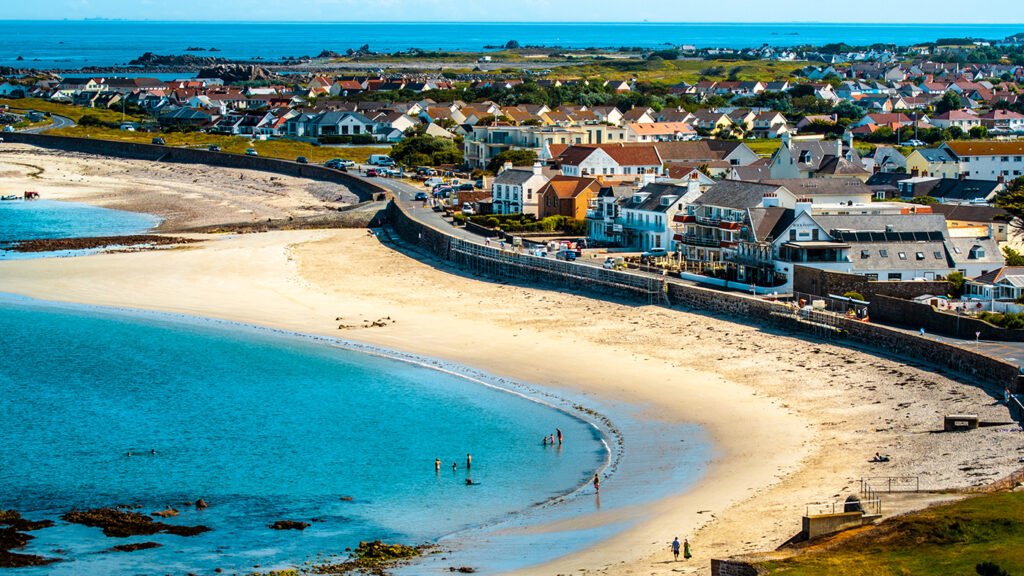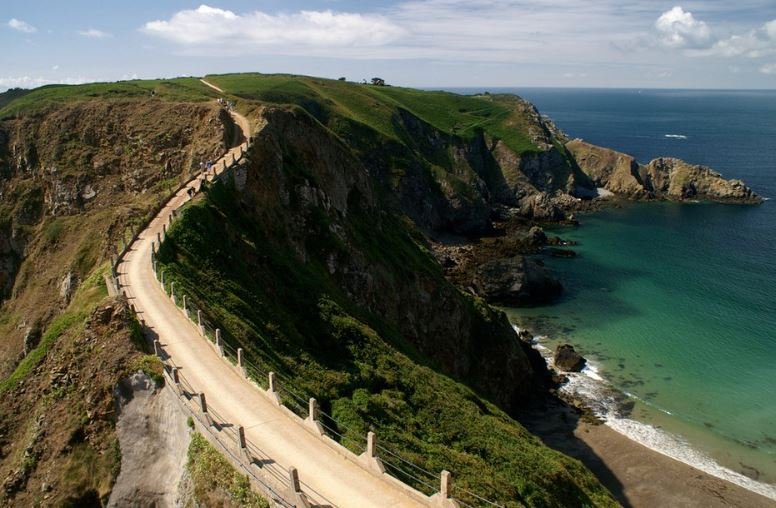Exploring the Channel Islands: Jersey and Guernsey

Nestled in the English Channel, just off the coast of Normandy, the Channel Islands of Jersey and Guernsey offer a unique blend of British formality and French charm. These islands, part of the British Crown Dependencies, are neither part of the United Kingdom nor the European Union, giving them a distinct identity. Known for their stunning beaches, rich history, and tax-haven status, Jersey and Guernsey are perfect for travelers seeking a mix of relaxation, adventure, and cultural discovery.
A Unique Status: British, Yet Independent
Jersey and Guernsey are autonomous territories with their own governments, currencies (Jersey pound and Guernsey pound), and legal systems, blending British, French, and Norman traditions. As British Crown Dependencies, they are represented by the British Crown, currently King Charles III, but manage their internal affairs independently. Their financial sectors thrive as offshore hubs, with Jersey focusing on banking and trusts, and Guernsey excelling in funds and insurance. Corporate tax is 0% on both islands, while Jersey has a 5% GST, and Guernsey has none, making them attractive for businesses and visitors alike.
| Island | Jersey | Guernsey |
|---|---|---|
| Area | 119.6 km² | 78 km² |
| Population | ~105,000 | ~65,000 |
| Capital | St. Helier | St. Peter Port |
| Currency | Jersey pound (JEP) | Guernsey pound (GGP) |
| GST | 5% | 0% |
| Corporate Tax | 0% | 0% |
Getting to the Channel Islands

By Air
Both islands are accessible via their international airports: Jersey Airport (JER) and Guernsey Airport (GCI). Regular flights operate from major UK cities like London (Heathrow, Gatwick), Manchester, and Southampton, with carriers such as British Airways and Aurigny Air Services. Seasonal flights connect from Paris, Brussels, and German cities. Allow ample time for connections, especially at busy hubs like Heathrow, where terminal transfers can be time-consuming.
- Flight Costs: Round-trip from London starts at ~£100–£200, depending on the season.
- Tip: Check Aurigny for inter-island flights or connections to smaller islands like Alderney.
By Ferry
Ferries are a scenic option, departing from French ports like St. Malo (1–2 hours to Jersey) or UK ports like Poole (5 hours) and Portsmouth (up to 12 hours). Companies like Condor Ferries and Manche Iles Express operate these routes. Ferries between Jersey and Guernsey run less frequently, typically morning or evening, due to extreme tides affecting port access.
- Ferry Costs: Jersey–Guernsey one-way ~£40; St. Malo–Jersey ~£50–£80.
- Tip: Book ferries well in advance, especially in summer, and arrive 60–90 minutes early for check-in. Note that UK visitors need an Electronic Travel Authorisation (ETA) for entry.
Transportation on the Islands
Jersey
Jersey’s compact size (14×8 km) makes it ideal for exploration by car, bike, or public transport. LibertyBus operates a reliable network from Liberation Station in St. Helier, with fares starting at £1.30 for a single trip or £8 for a 24-hour pass. Car rentals are available at the airport and in St. Helier, costing ~£30–£80/day. Biking is popular, with flat terrain and dedicated paths, though main roads can be busy.
- Key Routes: Bus 1 to Mont Orgueil Castle (~15 minutes, £2.30).
- Tip: Check tide times before coastal walks, as the 12-meter tidal range can be dangerous.
Guernsey
Guernsey’s smaller size (62 km²) and narrower roads favor biking or walking, especially in St. Peter Port. Guernsey Buses cover the island, with flat fares of £1.25 per ride or £4.50 for a day pass. Car rentals cost ~£35–£90/day, but parking in St. Peter Port is limited. Ferries to smaller islands like Sark (£33 round-trip, 50 minutes) and Herm (£18 round-trip, 15 minutes) depart from St. Peter Port.
- Tip: Sark is car-free; opt for a bike rental or horse-drawn carriage for a unique experience.
Distances and Travel Times
Both islands are small, with key destinations easily reachable within 30–60 minutes.
| Route | Distance (km) | Car/Bus Time | Mode |
|---|---|---|---|
| Jersey: St. Helier – Airport | 7 | 15–20 min | Car/Bus/Taxi |
| St. Helier – Mont Orgueil | 10 | 15–20 min | Bus 1/Car |
| Guernsey: St. Peter Port – Airport | 5 | 10–15 min | Car/Bus/Taxi |
| St. Peter Port – Parish of Forest | 8 | 15–20 min | Car/Bus |
| Jersey – Guernsey | 43 (by sea) | 1–2 hours | Ferry |
Must-Visit Attractions
Jersey
- Elizabeth Castle: A historic fortress in St. Helier, accessible by foot during low tide or by ferry (£15 entry).
- Jersey Zoo: Founded by Gerald Durrell, a sanctuary for endangered species (£18.50 entry, 15 minutes from St. Helier).
- Mont Orgueil Castle: A 13th-century fortress overlooking Gorey Harbour (£14 entry).
- Minquiers: A remote reef with the southernmost British public toilet, accessible by guided boat tours (~£100).
Guernsey
- Hauteville House: Victor Hugo’s eccentric former home in St. Peter Port, now a museum (£10 entry).
- St. Peter Port: A charming harbor town with colorful houses, cobblestone streets, and daily cannon firings.
- Sark: A car-free island with dramatic cliffs and La Coupée isthmus, ideal for biking or horse-drawn tours.
- Herm: A tiny island (2 km²) perfect for peaceful walks and pristine beaches.
Culinary Delights

Jersey and Guernsey boast a vibrant food scene influenced by French and British cuisines. Jersey’s Royal Potatoes and creamy dairy from local cows are staples, while Guernsey’s seafood shines. Try:
- Moules (mussels): Served with garlic and cream, rivaling French bistros (~£15–£20).
- Crab soup and octopus casserole: Popular in Guernsey’s restaurants like Christie’s (~£12–£18).
- Local cider and calvados: Apple-based drinks reflecting Norman heritage (~£5–£8).
Accommodation Challenges
Both islands see high demand, especially in summer, making accommodation pricey and scarce. In St. Helier, hotels like the Radisson Waterfront charge £300+/night, while mid-range options like Ommaroo cost ~£100–£150 with breakfast. Guernsey’s hotels, often older, start at £120/night but may lack modern amenities. Book early, ideally 3–6 months in advance, via platforms like Booking.com.
- Tip: Check smaller guesthouses or Airbnb for better rates, especially outside peak season (April–May, September–October).
Practical Tips
- Tides: The 12-meter tidal range can trap unwary visitors on beaches. Check tide schedules daily.
- Currency: Jersey and Guernsey pounds are interchangeable on both islands but not accepted elsewhere. ATMs dispense local currency; card payments are widely accepted.
- Language: English is primary, but French street names and menus reflect Norman heritage. On Sark, the Sercquiais dialect is rare but cherished.
- Weather: Expect mild summers (up to 25°C) and cool winters. Pack layers for unpredictable rain.
- Connectivity: Wi-Fi is reliable in main towns, but rural areas may have weaker signals.
Why Visit Jersey and Guernsey?
Jersey and Guernsey are hidden gems offering a blend of history, nature, and luxury. From Jersey’s dramatic tides and Durrell’s zoo to Guernsey’s flower-filled streets and Victor Hugo’s legacy, these islands deliver an unforgettable escape. Whether cycling Sark’s car-free paths or savoring fresh seafood in St. Peter Port, the Channel Islands promise a unique adventure just a short hop from mainland Europe.
Plan a long weekend or a week-long retreat to these “exotic corners of Europe.” With their safety, accessibility, and distinct charm, Jersey and Guernsey are destinations that will surprise and delight even the most seasoned travelers.



